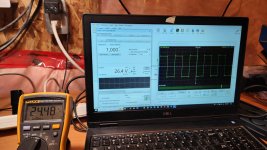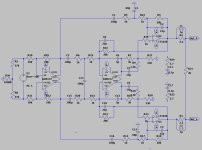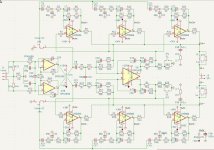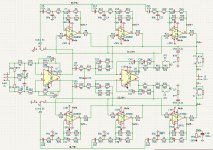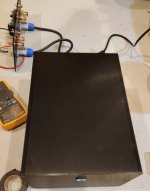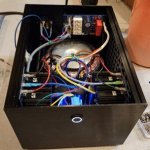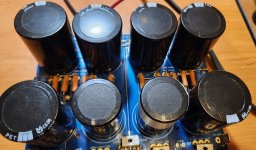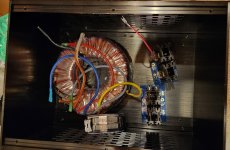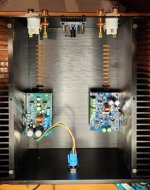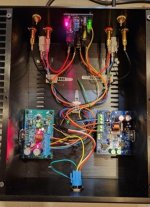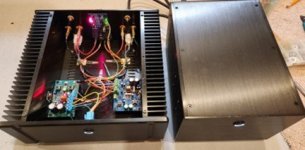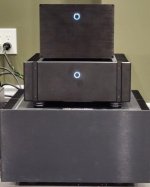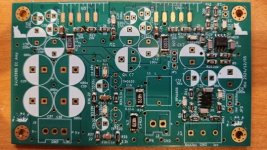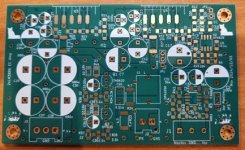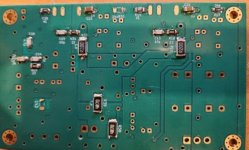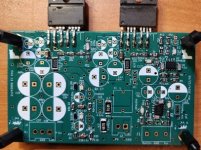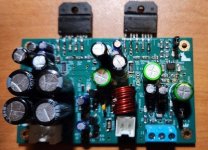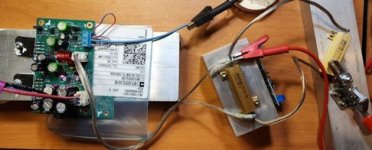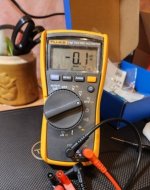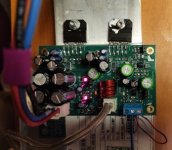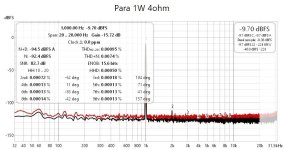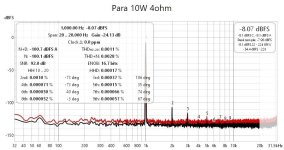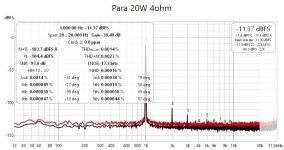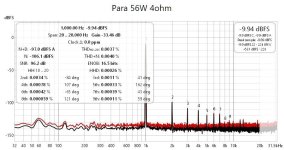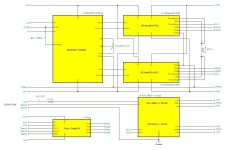This is a tweeter eater. I'd try to reduce that parasitic oscillation if you can. Some is probably avoidable in a composite design. But it's good news that it recovers after.

I would also look at the clipping behaviour with a square wave.
Tom
I would also look at the clipping behaviour with a square wave.
Tom
Thank you Tom! I learnt a lot from you, your tests, your PCB layout. I am really very appreciated.
I will looking for another capacitor. This 0.47u capacitor is from a old valve amp. Because it is a foil capacitor and might have larger inductance. The larger 2.2u one is stacked film capacitor.
I will try square wave, too.
It took me few days to get this amp stable. After two key capacitors(C16, C17) are selected correctly, it becomes very stable. I tried to change other elements value, it stays stable stubbornly.
Another thing is worth mentioning this amp can work at a low gain of x5.8 at 4 ohm load. This is normally not easy for LM3886.
It can be found from the picture, all OPs are installed with DIP8 adaptor, all those compensating capacitors are stick high in air. These factors are not ideal for an small THD+N amp. I hope it will be better when they are properly done in the future with my version2 PCB.
My next one will be parallel LM3886 EC-Comp amp. At same time, I am looking for a proper PW and case for the amp.
Thank you again.
I will looking for another capacitor. This 0.47u capacitor is from a old valve amp. Because it is a foil capacitor and might have larger inductance. The larger 2.2u one is stacked film capacitor.
I will try square wave, too.
It took me few days to get this amp stable. After two key capacitors(C16, C17) are selected correctly, it becomes very stable. I tried to change other elements value, it stays stable stubbornly.
Another thing is worth mentioning this amp can work at a low gain of x5.8 at 4 ohm load. This is normally not easy for LM3886.
It can be found from the picture, all OPs are installed with DIP8 adaptor, all those compensating capacitors are stick high in air. These factors are not ideal for an small THD+N amp. I hope it will be better when they are properly done in the future with my version2 PCB.
My next one will be parallel LM3886 EC-Comp amp. At same time, I am looking for a proper PW and case for the amp.
Thank you again.
Nice!This Error-Correction/Composite Combo amp is based on Mr Evil "Unnamed feedback method explored" and Nickolay Shvydky "My ZD-50 ultralow distortion chipamp"
Output power at +/-29.5V: 8 ohms clip at 42W, 4 ohm clip at 65W. It is very stable in both EC and Comp mode. Ans it behaves very well after clipping.
I could only measure its THD+N very roughly using Focusrite Solo 3rd, which has a minimal line-out and line-in THD+N of 0.002%.
U1 is OPA1655 and U2 is OPA828. For error-correction(EC) mode, RV1 was set at 330ohm. For composite (Comp) mode, RV1 was set at 680 ohms.
Be aware of possible stability issues under capacitive loads.
It looks like that composite architecture enjoys a lot of fans.
A couple of months ago I came across this post - https://www.eevblog.com/forum/proje...er-utilizing-lm388676!/msg5577585/#msg5577585
Very solid performance and quite simple schematic. Maybe the simplest composite utilizing LM3886.
Be aware of possible stability issues under capacitive loads.
Please see my test. it can drive 8ohm resistor parallel to 2.2u capacitor. #20
Error Correction and Composite Amp can be in one circuit. But they are not same.
Please see my test. it can drive 8ohm resistor parallel to 2.2u capacitor. #20
Error Correction and Composite Amp can be in one circuit. But they are not same.
I read just the opening post, didn't see your test results. Now I'm looking at post #20 and that oscillation doesn't look nice. Reducing R7 and RV1 to max may help.
In your circuit you have both - composite and error correction but if you prefer to consider it just as an error correction amp it is up to you.
In your circuit you have both - composite and error correction but if you prefer to consider it just as an error correction amp it is up to you.
You've switched to bridge mode from the previous parallel. Have you done any testing or you are experimenting ?
I am waiting for PCB of the parallel amp. The shipment is delayed because of the post strike. At same time the case and power supply are prepared.
I have Modulus-86 10th Edition as well. The single LM3886 version will be listened at first.
Then the parallel version will be tested.
The BTL version is the last one I'd like to explore on LM3886 chip.
I have Modulus-86 10th Edition as well. The single LM3886 version will be listened at first.
Then the parallel version will be tested.
The BTL version is the last one I'd like to explore on LM3886 chip.
EC-Comp LM3886 Parallel amp
Attachments
Power On! No surprise, everything works.
DC offset at speaker output less than +/-1mv. The voltage difference between 2 LM3886 Pin 3(output), is only +/-0.1mv, well balanced.
It passed all tests, include capacitance load, clipping behavior, and square wave.
Only found out that OPA1556 a little bit disappointing. It works at +/-1 gain as buffer, but there is overshooting at both +/- 1 gain even at 1khz.
I will change it in the future version.
DC offset at speaker output less than +/-1mv. The voltage difference between 2 LM3886 Pin 3(output), is only +/-0.1mv, well balanced.
It passed all tests, include capacitance load, clipping behavior, and square wave.
Only found out that OPA1556 a little bit disappointing. It works at +/-1 gain as buffer, but there is overshooting at both +/- 1 gain even at 1khz.
I will change it in the future version.
Attachments
I suggest turning the peak trace off. It'll make the graph easier to read. Just click the Hidden checkbox in the trace setup.
What's your test limit for THD and THD+N? That should be the limiting factor in your measurements.
Tom
What's your test limit for THD and THD+N? That should be the limiting factor in your measurements.
Tom
Tom, Thank you! The focusrite scarlett solo I use has very limited usability in the measurement. I keep turning the poti to get the input not clipping. So the peak of the signal keeps changing so the SNR. It can just tell me if the amp is working or whether it is oscillating.
I found a fatal error of pure EC-mode in parallel LM3886 amp. It is stable at lower output level but not stable at higher power.
When feeding the error signal from common output of two LM3886, it is nether the error from LM3886 A nor the error from B. The error op cannot tell the mixture. Then this will make no sense in the real world.
I also simulated the EC-Parallel LM3886 in LTSpiec again. This time I change the some resistors value in feedback loop to nominal+ or -0.1% to simulate the real word components value variations. At lower input signal level, when monitoring the signal at the input of error op, it look still like a sine wave shape. When increasing the level of input signal, the error signal because sharp pulses train and amplified by the EC- op and feed to LM3886. This will bring the amp to oscillating right away.
Fortunately, I designed the PCB in such a way it can be used either as EC- or Comp amp.
Now I am testing those resistors and capacitors value and get a stable parallel LM3886 composite amp.
You have been so kind to help us in LM3886 amp.
Now I am using SE input for the amp, there is still a difference in the circuit topology between non-inverted and inverted composite amp. If I start using balanced input in the front, the difference between two could be diminish. I can see my route towards that direction already.
When I am done with current parallel LM3886 composite amp, I will still do a Parallel-BTL version. That will be the end of my diy with LM3886 and go back to Pass land.
I found a fatal error of pure EC-mode in parallel LM3886 amp. It is stable at lower output level but not stable at higher power.
When feeding the error signal from common output of two LM3886, it is nether the error from LM3886 A nor the error from B. The error op cannot tell the mixture. Then this will make no sense in the real world.
I also simulated the EC-Parallel LM3886 in LTSpiec again. This time I change the some resistors value in feedback loop to nominal+ or -0.1% to simulate the real word components value variations. At lower input signal level, when monitoring the signal at the input of error op, it look still like a sine wave shape. When increasing the level of input signal, the error signal because sharp pulses train and amplified by the EC- op and feed to LM3886. This will bring the amp to oscillating right away.
Fortunately, I designed the PCB in such a way it can be used either as EC- or Comp amp.
Now I am testing those resistors and capacitors value and get a stable parallel LM3886 composite amp.
You have been so kind to help us in LM3886 amp.
Now I am using SE input for the amp, there is still a difference in the circuit topology between non-inverted and inverted composite amp. If I start using balanced input in the front, the difference between two could be diminish. I can see my route towards that direction already.
When I am done with current parallel LM3886 composite amp, I will still do a Parallel-BTL version. That will be the end of my diy with LM3886 and go back to Pass land.
The whole purpose of my test is to reduce THD+N at higher frequency where LM3886 has its limited OPG. Unfortunately I couldn't verify it.Significant improvement at low power.
At high power mot much difference in comparison to the conventional application, still good though.
This one is very popular in former of Yugoslavia countries, 1000+ builds, please take a look for the whole thread for some details. Its able to drive capacitor 4.7uF directly and to not have any anomaly. It have remote sensing directly from speaker terminals... etc, might help.
https://www.diyaudio.com/community/threads/bridged-lm3886-lme49720-remote-fb.255612/
There is some plans for full bridge concept, BatoMDM with remote sense from speaker terminals.
https://www.diyaudio.com/community/threads/bridged-lm3886-lme49720-remote-fb.255612/
There is some plans for full bridge concept, BatoMDM with remote sense from speaker terminals.
Attachments
Last edited:
- Home
- Amplifiers
- Chip Amps
- A New EC-Composite LM3886 Amp
